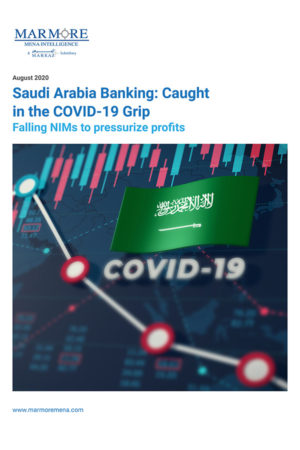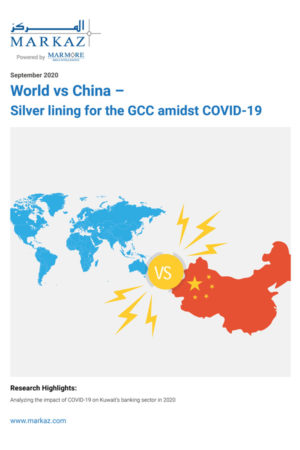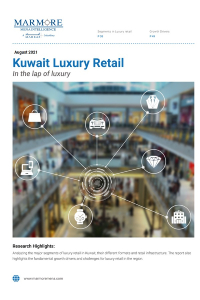Kuwait Banking Sector Outlook 2020
Asset quality under pressure as operating environment turns challenging
Pages : 39

Executive Summary
Analyzing the impact of COVID-19 on Kuwait banking sector in 2020
The report titled ‘Kuwait Banking Sector Outlook 2020’ examines banking sector in Kuwait, provides an in-depth analysis of the industry and discusses about the challenges posed by the economic impact of COVID-19. The report discusses key parameters such as credit growth, asset quality, profitability and liquidity, and provides forecasts for 2020 considering the current economic conditions. The report also identifies emerging trends and contains the profiles of listed domestic banks.
Key Highlights
- COVID-19 is expected to add considerable strain to Kuwait banking sector in 2020 and 2021. Lockdown measures and subsequent plunge in oil prices is expected to reduce economic activity to levels not seen in decades.
- The unique nature of the crisis, where both the supply and demand have been impacted needs to be effectively addressed by policy measures. Lack of sizeable fiscal stimulus to support the economy and spurt in distressed businesses could increase the burden for the banking sector and the costs in the long-term could be prohibitive.
- With the business environment immensely challenged amidst the COVID-19 pandemic, demand for financing and credit to sustain businesses (particularly SMEs) amid near-zero revenues has surged. Kuwait government has extended benefit measures for SMEs in the form of subsidized loans (interest waivers). However, the onus of loan origination, administration, and due diligence checks fall on banks exacerbating operational risk.
- Credit growth is expected to fall to 4.0% for 2020 on a year-on-year basis due to the fall in economic output. Supply-side constraints like labor force shortfalls in expat-dominated sectors are also expected to keep economic activity subdued.
- Deposit growth is expected to fall to 5.0% for 2020, down from 8.1% witnessed in the previous year. Possible job losses and lower interest rates for deposits are expected to drive the contraction. Further interest rate cuts to stimulate economic growth will have negative outcomes in deposit mobilization.
- Defaults are likely to be more in sectors such as real estate, where the financial leverage of some borrowers may be relatively large. Gross NPLs are expected to shoot up to 4.7% in 2020, up from 1.8% in 2019.
- During the Global Financial Crisis (GFC), Kuwait economy contracted by 7.1% largely due to fall in the oil economy while the non-oil sector witnessed growth. The losses in the financial market percolated through Investment Companies (ICs), which accounted for 13% of loans outstanding in 2009. Subsequently, gross NPAs increased to 11.8% of total loans in 2009 from an earlier value of 6.8% in 2008.
To learn more, download the full report.
Table of Content
- Executive Summary
- Operating Environment turns Challenging as Stimulus Measures Fall Short of Expectations
- SMEs in a spotlight of bother
- Credit Growth
- Deposit Growth
- Non-Performing Assets
- Net Income
- What could change the narrative for Kuwait banking?
- Digitization trends
- Conclusion
- Appendix
Key Questions Addressed in this report
This report can add value to
Customize this report
Why Custom Research?
- Research and intelligence to suit your business requirements
- Informed decision making
What are Benefits of Customization?
- To-the-point, long or short research reports could be requested
- Reports are exclusively prepared for you
You Ask We Deliver
- Over a decade Marmore has successfully navigated this space of customized research to serve its clients and cater to their unique requirements.
- Our customized research support spans sector research, equity and credit investment notes, modelling, valuation, investment screening, periodical etc.
- نزود العملاء بمعلومات وآراء في مجالات لا تزال غير مستكشفة بهدف تزويدهم بالمعلومات اللازمة لاتخاذ قرارات استراتيجية مدروسة.
- Our offerings marries the challenges of cost, time, scope & data availability to generate actionable outcomes that are specific to our clients’ needs.
الاستفسارات الشائعة
Is regular update for this available?The report will be updated yearly. However, if required, upon specific request we could provide you with an update.
Can I only download certain sections of the report?
No. The report can be downloaded in full length only.
Executive Summary
Analyzing the impact of COVID-19 on Kuwait banking sector in 2020
The report titled ‘Kuwait Banking Sector Outlook 2020’ examines banking sector in Kuwait, provides an in-depth analysis of the industry and discusses about the challenges posed by the economic impact of COVID-19. The report discusses key parameters such as credit growth, asset quality, profitability and liquidity, and provides forecasts for 2020 considering the current economic conditions. The report also identifies emerging trends and contains the profiles of listed domestic banks.
Key Highlights
- COVID-19 is expected to add considerable strain to Kuwait banking sector in 2020 and 2021. Lockdown measures and subsequent plunge in oil prices is expected to reduce economic activity to levels not seen in decades.
- The unique nature of the crisis, where both the supply and demand have been impacted needs to be effectively addressed by policy measures. Lack of sizeable fiscal stimulus to support the economy and spurt in distressed businesses could increase the burden for the banking sector and the costs in the long-term could be prohibitive.
- With the business environment immensely challenged amidst the COVID-19 pandemic, demand for financing and credit to sustain businesses (particularly SMEs) amid near-zero revenues has surged. Kuwait government has extended benefit measures for SMEs in the form of subsidized loans (interest waivers). However, the onus of loan origination, administration, and due diligence checks fall on banks exacerbating operational risk.
- Credit growth is expected to fall to 4.0% for 2020 on a year-on-year basis due to the fall in economic output. Supply-side constraints like labor force shortfalls in expat-dominated sectors are also expected to keep economic activity subdued.
- Deposit growth is expected to fall to 5.0% for 2020, down from 8.1% witnessed in the previous year. Possible job losses and lower interest rates for deposits are expected to drive the contraction. Further interest rate cuts to stimulate economic growth will have negative outcomes in deposit mobilization.
- Defaults are likely to be more in sectors such as real estate, where the financial leverage of some borrowers may be relatively large. Gross NPLs are expected to shoot up to 4.7% in 2020, up from 1.8% in 2019.
- During the Global Financial Crisis (GFC), Kuwait economy contracted by 7.1% largely due to fall in the oil economy while the non-oil sector witnessed growth. The losses in the financial market percolated through Investment Companies (ICs), which accounted for 13% of loans outstanding in 2009. Subsequently, gross NPAs increased to 11.8% of total loans in 2009 from an earlier value of 6.8% in 2008.
To learn more, download the full report.
Table of Content
- Executive Summary
- Operating Environment turns Challenging as Stimulus Measures Fall Short of Expectations
- SMEs in a spotlight of bother
- Credit Growth
- Deposit Growth
- Non-Performing Assets
- Net Income
- What could change the narrative for Kuwait banking?
- Digitization trends
- Conclusion
- Appendix
Key Questions Addressed in this report
This report can add value to
Customize this report
الاستفسارات الشائعة
Is regular update for this available?The report will be updated yearly. However, if required, upon specific request we could provide you with an update.
Can I only download certain sections of the report?
No. The report can be downloaded in full length only.





